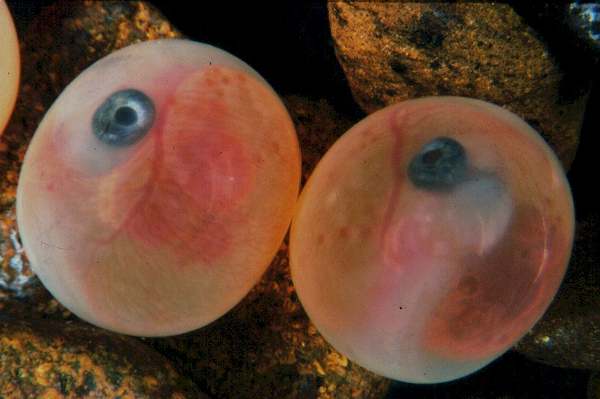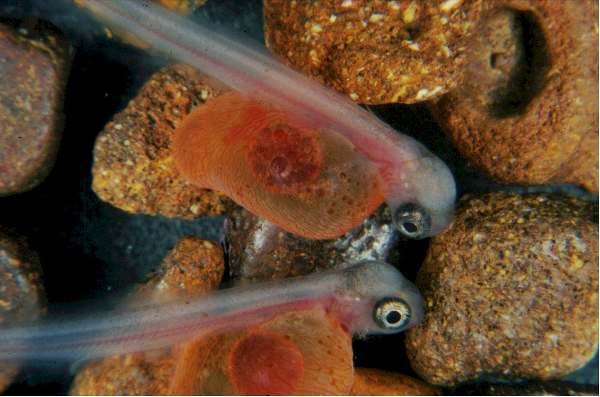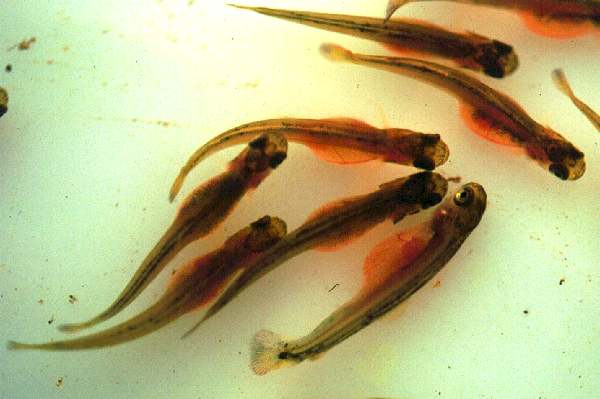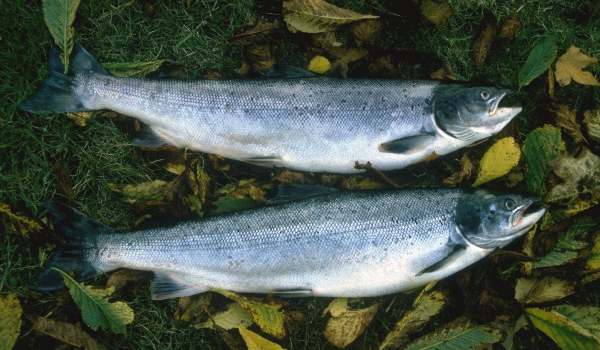Trees Birds Mammals Fish Amphibians Reptiles
Wild Algarve
Bookshop
Salmo salar - Atlantic salmon
Phylum: Chordata - Class: Actinopterygii - Order: Salmoniformes - Family: Salmonidae

Eggs, or ova (Picture: Nick Giles)
Salmon eggs
In winter, adult salmon lay their eggs (called ova) in redds, which are
nests that the hen salmon digs in the gravel of the river bed. The cock
salmon fertilises the eggs with his milt.
After a few weeks, tiny black eyes appear inside the ova, and soon
afterwards the heart and other internal organs become visible. Salmon ova
take typically three months to hatch; cold winters delay the hatching and
in warmer years the process is speeded up a bit.
Alevins

Alevins (Picture: Nick Giles)
When the baby salmon is ready, it bursts free from the egg's soft shell
and lies buried under the gravel. At this stage it is called an alevin,
and it gets nourishment from a yolk sac, hanging down beneath its neck.
Salmon fry
Once the alevins have absorbed their yolk sacs, the tiny fish must learn
to swim and to fend for themselves. At this stage they are called salmon
fry.
Salmon fry hide under stones and among the bank-side vegetation where
they are able to set up feeding territories and avoid predators;
nevertheless, many are eaten by herons,
water
beetles and other kinds of fishes.
Salmon parr
When they are several months old, the young salmon develop very noticeable
markings, rather like finger marks, along their flanks. They are then
termed salmon parr, and they live among boulders and beside submerged weed
beds in the shallow glides.

Fry (Picture: Nick Giles)
Parr feed for at least one year, more normally two and occasionally
three years (depending on the availability of food in their river) before
they are ready to go out to sea. At that time they are typically 15
cm (6 inches) long.
Salmon smolts
The parr turn silver, losing their distinctive parr markings, when they
are ready to make the journey down river.
In late spring, the salmon smolts shoal together. Then, when the river
is high after rain, they travel down to the estuary. After taking a few
days to get used to the salty water, the smolts head off out to sea.
Adult salmon in the sea
Even in the high seas, the salmon is not safe. Fishing boats take many
salmon in the high seas, although internationally agreed quotas now limit
the catch from most fisheries.

Salmon smolt (Picture: Nick Giles)
Bigger problems await the salmon on their return journey to the rivers
of their birth. Coastal drift-net fisheries off north-east England and off
the west coast of Ireland take many hundreds of tonnes of salmon each
year.
Home at last
Once inside the estuary of the river in which they were born, the salmon
have to escape the seals, cormorants and seine nets in the estuary and
maybe coracles in the tidal reaches of the river. Then (assuming they
don't end up in a poacher's gill net) they run the risk of being caught by
anglers, who are very good at capturing the very big spring-running salmon
that spend two or more years feeding in the sea.

The king of the river, the Atlantic salmon is greatly prized as a sport
fish. Although salmon of more than 40lb (18kg) have been caught in Wales
in recent years, the runs of large spring fish have greatly declined - as
they have in all countries bordering the North Atlantic. The autumn
migration into Welsh rivers remains substantial, and the sight of these
majestic fish leaping the falls is a source of fascination and pleasure to
visitors and local people alike.
Spawning time
Usually in November, December and January, the salmon pair up and redd
cutting begins. A hen salmon may take several days to lay all her eggs and
cover them over with gravel.
After spawning, most of the cock fish die. Some of the hen fish and one
or two cock fish will survive as 'kelts' in the river. (In spring, any
kelts caught by fishermen must be returned to the river.) Only a few will
make it back to sea, where the salt water helps them get back into good
health.
Occasionally, a salmon will spawn two, three or even more times; by
then it is likely to be a very big fish indeed. Fish of over 50lb have
been caught from Welsh rivers. The British rod-caught record is 64lb
(approx 30kg).
Excited at the prospect of flyfishing? So are we, and we're pretty sure you would find the Winding River Mystery trilogy of action-packed thrillers gripping reading too. Dead Drift, Dead Cert, and Dead End are Pat O'Reilly's latest river-and-flyfishing based novels, and now they are available in ebook format. Full details on our website here...
Buy each volume in ebook format for only £2.47 on Amazon... Paperbacks also available on Amazon at £6.95 each. All proceeds go towards keeping the First Nature website online.
Please Help Us: If you have found this information interesting and useful, please consider helping to keep First Nature online by making a small donation towards the web hosting and internet costs.
Any donations over and above the essential running costs will help support the conservation work of Plantlife, the Rivers Trust and charitable botanic gardens - as do author royalties and publisher proceeds from books by Pat and Sue.